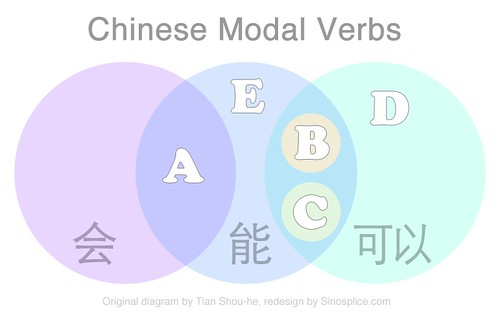Chinese Modal Verb Venn Diagram
I’m a bit of a sucker for Venn diagrams. When I was recently asked by a student about the Chinese modal verbs 会, 能, and 可以 (all of which can be translated into English as “can”), I recalled a nice Venn diagram on the topic and dug it up.
What creates the most confusion with these three modal verbs is not that they can all be translated into “can” in English. The problem is that they are usually explained over-simplistically something like this:
> 会: know how to
> 能: be able to
> 可以: have permission to
This is not a bad start, but this sort of definition is eventually revealed as insufficient to the learner because in usage, the three modal verbs actually overlap. Enter the Venn diagram. The image below is a reconstruction of the one on page 95 of Tian Shou-he’s A Guide to Proper Usage of Spoken Chinese:
> A = ability in the sense of “know how to” (“会” is more common than “能“)
> B = permission/request (use “能” or “可以“)
> C = possibility (use “能” or “可以“)
> D = permission not granted (use “不可以“)
> E = impossibility (use “不能“)
Yeah, grammar needs more Venn diagrams.
Update: I’ve been informed that this diagram is actually a Euler Diagram. Oops. I stand corrected. I should have read up on the requirements for Venn Diagrams first! (Hey, some of those extensions are pretty cool!)


Hey John, that’s pretty cool. One can learn a lot from 30 seconds with that Venn diagram.
It’s almost, but not quite, T-Shirt worthy, but I bet we could make one that was.
Well, just nitpicking, but a Venn (维恩) diagram must show all possible overlaps even if it is empty. So in fact that is a Euler (欧拉) diagram. Anyway, I’m more confused with the variants of ‘must’ – now that would be an interesting diagram.
annmarie,
Thanks for informing me! I have updated the post (although I fear it’s a bit late for the title).
Yeah. Personally I’m not so clear on the “shoulds”: (应)该,得,最好,只好
Good post! I could not help but to go through my Chinese grammar books to see how the teach modal verbs…and they don’t; they are usually presented in bulleted fashion which is not the best way of teaching modal verbs.
When new Mandarin students have asked me when they should use ”会”/ “能”/ “可以“, the only way I knew how to explain it was if you need to use head knowledge to do something, such as speaking Chinese, use ”会”. If the action requires physical ability, use “能”. Use “可以“ for or “能” for the other situations. This seems to keep me correct in about 90% of the situations I am in.
There is grey area with the use of these modal verbs. I do really appreciate the fresh approach to teaching modal verbs.
–Barak
Awesome! Thanks man, I’ve been struggling with the differences with the modal verbs for quite some time. This definitely clears things up. Also, I agree that the “shoulds” are also confusing as hell.
Hey John .. thanks for the post. How did you like the book (Tian Shou-he’s A Guide to Proper Usage of Spoken Chinese)? Is it helpful? Do you recommend it?
impossibility (use “不會吧!“)
heheh
Actually, I don’t think I ever formally memorized this stuff. I just kind of copied whole sentences at first and then tried to use whatever sounded “right” later.
Jaques,
The book is quite good if you’re looking to get some of the more confusing points of Mandarin straight. Lots of useful comparisons.
I think D and E also overlap. Actually, “不可以” sounds very effeminate when used with first person singular. I pretty much never use “可以” or “不可以” in spoken Chinese, but “(不)行” or “(不)能” instead… you know, in youth culture, esp for guys, words tend to be as short as possible… if a big white guy often say 我可以/我不可以… I’d suspect he’s a drag queen or something…
Hi, why not translate them directly to english?
会: know how to
能: can/could
可以: may/might
Abel, I don’t think it sounds feminine to use 不可以. I think it sounds more reproachful, if anything, like how you’d tell a child “no you may not go to the toilet”.
Actually, the areas the modals intersect are not as interesting as the examples that would lay on the two dimensional surfaces (lines) where they intersect each other.
These meeting surfaces are where explanations become the hardest and the most interesting. You would probably find Chinese people disagreeing with each other politely as to which camp words belong in. At the very least there would be regional variations.
My belief is that beginning students need to talk about examples that are at the center of each Venn bubble, while upper level students need to talk about examples on the common surfaces.
Just used this in my high school Chinese 2 class this week – Thanks!
What a great diagram. It’s taken me 2.5 years of Chinese to correct my conceptual issues about these words, which stem from the exact oversimplified teaching method you mention in the beginning of your post. This image should be found in about Chapter 6 of every beginning Chinese textbook.
Hi, accidentally found your blog when I was trying to search some chinese learning material for my Japanese friend. This blog is so GREAT for chinese learner.Btw, I’m chinese Malaysian. Thanks for your effort ^^
Hi Mark,
To most people who know Chinese Language, impossibility is “不可能”, “不會吧!” is not likely, “不會” is not possible / unable.
Regards,
Teh
I’m Italian, I’m studying chinese at university!
Your post is awesome! much more simpler than my grammar book…thankyou so much!
[…] (3) “有” puede ser usado con el verbo modal (?) […]
会 ‘can’ (mentally able)
能 ‘can’ (physically able)
可以 ‘may’ (have permission)
得 ‘must/have to’
I’m thinking that the order should be 会,可以,能 as 可以 can be used to express both knowledge based or physical ability.
Well, here goes, 4 years later…
In the sentence 我看不到. ‘I can’t see!’
Is “到” a modal verb?.